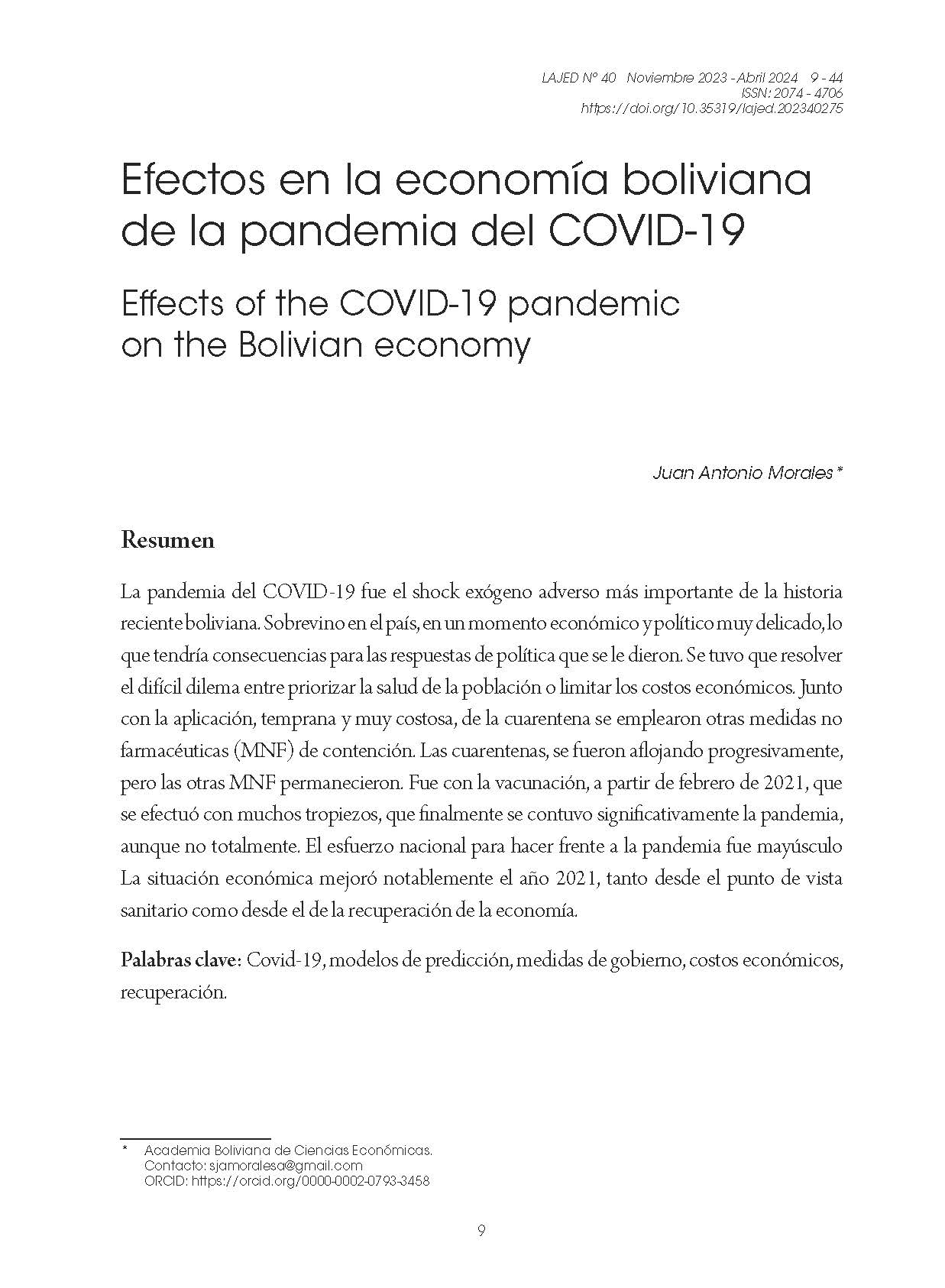Effects of the COVID-19 pandemic on the Bolivian economy
DOI:
https://doi.org/10.35319/lajed.202340275Keywords:
Covid-19, prediction models, government actions, economic costs, recoveryAbstract
The pandemic of COVID-19 was the most important adverse exogenous shock in the recent history of Bolivia. It appeared when the country was already experiencing severe economic and political difficulties, bearing on the responses to the shock. The authorities faced the difficult trade-off between prioritizing the health of the population and extremely high economic costs of containing the propagation of the disease. The early and reaction to enact a strict lockdown, partially respected by the population. Overtime the lockdowns were relaxed. Together with the lockdown other non-pharmaceutical measures (NPM) were implemented. Vaccination started in February 2021. Notwithstanding the haphazard way in which it was done, a significant sanitary progress was achieved. The national effort to check the pandemic was huge. The situation improved substantially in 2021, from both a sanitary viewpoint as well as from an economic angle.
Downloads
References
Ahuja, A., Athey, S., Baker, A., Budish, E., Castillo, J.C., Glennerster, R., Kominers, S.D., Kremer, M., Lee, J., Prendergast, C., Snyder, C.M., Tabarrok, A., Tan, B.J. y Wiecek, W. (2021). Private and social returns to R&D and vaccine development. Preparing for a Pandemic: Accelerating Vaccine Availability. American Economic Association. Papers and Proceedings, 111, 331-335.
Alberola. E., Arslan, Y., Cheng, C. y Moessner, R. (2020). The fiscal response to the Covid-19 crisis in advanced and emerging market economies. Bank for International Settlements, Bulletin N° 23, junio.
Álvarez, F., Argente, D. y Lippi, F. (2021). A Simple Planning Problem for COVID-19. Lock-down, Testing, and Tracing. American Economic Review: Insights, 3(3), 367-382.
Andersen, L y Gonzáles Rocabado, A. (2021). Vida y muerte durante el primer año de la pandemia COVID-19: un análisis de las diferencias entre países en los cambios en la cantidad y la calidad de vida. Revista Latinoamericana de Desarrollo Económico 19(35), 9-57.
Atkenson, A.C., Kopecky, K. y Sha, T. (2021). Behavior and the Transmission of COVID-19. Staff Report N° 618. Research Division Federal Reserve Bank of Minneapolis.
Bakker, B.B. y Goncalves, C. (2021). Covid-19 in Latin America: A high toll on lives and livelihoods. International Monetary Fund Working Paper WP/21/168.
Banco Central de Bolivia (2021). Estadísticas semanales al 01-10. https://www.bcb.gob.bo/?q=estad-sticas-semanales
Barja, G. (2021). Using mobility measures to explain short-run economic performance during COVID-19’s first wave. Ecos de Economía: A Latin American Journal of Applied Economics. 25(52), 6-17.
Barja, G. (2022). Impacto y recuperación económica ante el shock de la pandemia: perspectiva del contrafactual. Síntesis. Boletín informativo de la Fundación INESAD, 31, 2-9.
Blejer, M. y Nagy-Mohacsi, P. (2022). The New Crisis of Central Banking, Project Syndicate. https://www.project-syndicate.org/onpoint/central-banks-creating-massivemoral-hazard-by-mario-i-blejer-and-piroska-nagy-mohacsi-2022-02 Feb 4.
Bolton, P., Kacperczyk, M., Hong, H. y Vives, X. (2021). Resilience of the Financial System to Natural Disasters. Londres: Centre for Economic Policy Research.
Covid Live Update (2021). Worldometer. https://www.worldometers.info/coronavirus/
Cutler, D. M. y Summers, L.H. (2020). The COVID-19 Pandemic and the $16 Trillion Virus. Journal of the American Medical Association, 324(15),1495-9.
Escóbar, S., Rojas, B. y Arze, C. (2014). País sin industrias, país con empleos precarios. La Paz: Centro de Estudios para el Desarrollo Laboral y Agrario (CEDLA).
Eróstegui, R. y Cerff, R. (2020). Informe segundo sondeo a empresas impacto del Covid-19. La Paz: Federación de Empresarios Privados de La Paz.
Fondo Monetario Internacional (2021). World Economic Outlook Database (WEO). https://www.imf.org/en/Publications/WEO/weo-database/2021/Octubre.
---------- (2021). Primary commodity prices. https://www.imf.org/en/Research/commodity-prices. Octubre.
Furceri, D. y Zdzienicka, A. (2018). Twin Deficits in Developing Economies. International Monetary Fund, Working Paper WP/18/170.
Furceri, D., Ganslmeier, M., Ostry, J.D. y Yang, N. (2021). Initial output losses from the Covid-19 pandemic: Robust determinants. International Monetary Fund, Working Paper WP/21/18.
Gourinchas, P.O. (2020). Flattening the Pandemic and Recession Curves. UC Berkeley.
Hausmann, R. (2021). The Macro-Economic Implications of COVID-19 in our partner countries. Cambridge, Ma: Harvard Kennedy School.
Instituto Nacional de Estadística (2020). Encuesta de hogares 2020. https://www.ine.gob.bo/index.php/censos-y-banco-de-datos/censos/bases-de-datos-encuestas-sociales/
---------- (2021). Cuentas nacionales. Datos trimestrales. https://www.ine.gob.bo/index.php/estadisticas-economicas/pib-y-cuentas-nacionales/producto-interno-brutotrimestral/producto-interno-bruto
King, M. (2020). Why the Covid pandemic is a classic example of radical uncertainty. https://moneyweek.com/economy/uk-economy/601429/mervyn-king-why-the-covidpandemic-is-a-classic-example-of-radical uncertainty
Molina, G. (2020). ¿La deuda pública ante el Coronavirus-Covid19? Academia Boliviana de Ciencias Económicas. https://www.abce-edu.org/wp-content/uploads/PB-German-Molina1.pdf
Morales, J.A. (2022a). ¿Por qué la inflación boliviana es tan baja? Público.bo. https://publico.bo/economia/por-que-la-inflacion-boliviana-es-tan-baja
---------- (2022b). “El desempeño del sistema financiero”. Universidad Católica Boliviana, Maestrías para el Desarrollo. Manuscrito.
Muriel, B. (2021). El contexto laboral y la Covid-19 en Bolivia. Un ensayo. Foro Económico de la Fundación Vicente Pazos Kanki.
Murray, E.J. (2020). Epidemiology’s Time of Need: COVID-19. Calls for Epidemic-Related Economics. Journal of Economic Perspectives, 34(4), 105-120.
OECD/ILO (2019). Tackling Vulnerability in the Informal Economy, Development Centre Studies, OECD Publishing, París. https://doi.org/10.1787/939b7bcd-en
Our World in Data (2022) “Covid-19 Data set” covid-19-data/public/data/
Ortuño, A. (2021). “Los pobres en tiempos del COVID: algunos apuntes desde Bolivia”. Foro Económico de la Fundación Vicente Pazos Kanki.
Pragyan, D., Furceri, D., Ostry, J.D. y Tawk, N. (2020). The economic effects of Covid-19 containment measures. International Monetary Fund Working Paper WP/20/158.
Rogoff, K. (2022). Emerging Market Sovereign Debt in the Aftermath of the Pandemic. Journal of Economic Perspectives,Volume 36(4), 147-166.
The Economist (2022). Corona virus excess death tracker https://www.economist.com/graphic-detail/

Downloads
Published
How to Cite
Issue
Section
License
Copyright (c) 2023 Revista Latinoamericana de Desarrollo Económico

This work is licensed under a Creative Commons Attribution-NonCommercial 4.0 International License.





